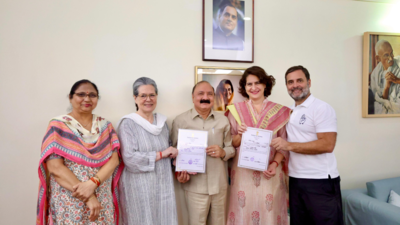- News
- City News
- lucknow News
- Cadre, personality clash: How Congress reclaimed Amethi
Trending
Cadre, personality clash: How Congress reclaimed Amethi
Congress reclaimed Amethi with Kishori Lal Sharma defeating Smriti Irani by a significant margin, impacting the 2024 elections narrative.

LUCKNOW: The reclamation of Amethi will be etched in Congress’s history books. Kishori Lal Sharma, a dedicated party cadre since 1983, ousted sitting BJP MP and Union minister Smriti Irani by a margin of 1.67 lakh votes — three times the number of votes with which she defeated Rahul Gandhi in 2019. Sharma secured more votes than Irani across all assembly segments.
TOI takes a look at what turned the tables for Congress.

Element of surprise
Experts believe Sharma’s candidacy benefited Congress by maintaining the “Rahul versus Modi” narrative for the 2024 elections and disrupting the local BJP unit’s plans for a “Rahul versus Irani” contest. Also, having a committed cadre as a candidate strengthened the otherwise frail Congress organisation.
Clash of personalities
Sharma, a seasoned behind-the-scenes worker for Congress, presented a stark contrast to Irani in terms of personality. Known locally as “Kishori Bhaiya”, his speeches were simple, crisp, and effective, emphasising his connection to the constituency: “Mai Amethi ka neta nahi beta hoon… aakpa kishori hoon (I am not Amethi’s leader but your son, I am your own Kishori).” This approach contrasted with Irani’s emphatic pitch, further fuelled by anti-incumbency against her.
Son-of-the-soil factor
Sharma employed his deep knowledge of Amethi constituency to consolidate Congress’s voter base, a task he had been performing since 1992. Starting May 6, Sharma personally visited over 1,900 booths across the constituency in just 13 days. “Since Kishori Bhaiya knows the villages in Amethi like the back of his hand, the familiarity allowed him to cover more ground quickly,” said Anil Mishra, a member of his team.
Sharma also rallied support from old Congress cadres who had distanced themselves from the party since the 2019 debacle. Priyanka’s involvement as Sharma’s campaign leader added a personal touch, revitalising the party’s efforts.
Caste calculus
Sharma’s use of his surname helped attract Brahmin votes, an estimated 2.25 lakh in the constituency. “The use of the title Pandit Kishori Lal Sharma instead of KL Sharma was a message to Brahmin voters,” said political commentator JN Shukla.
Sharma also connected with Yaduvanshi (Yadav) voters by visiting revered temples, such as Nand Mahar Mandir, and engaging with OBC members with the help of Samajwadi Party workers. A joint rally by Rahul and SP chief Akhilesh Yadav provided the final push to the campaign. Crediting his victory to the support of SP cadres and Priyanka’s campaign leadership, Sharma described his success as a triumph of “pure love and teamwork” over “arrogance and over-confidence”.
TOI takes a look at what turned the tables for Congress.

Element of surprise
The 62-year-old Sharma wasn’t the initial choice for Amethi. While Rahul was expected, his sister Priyanka Gandhi Vadra was the preferred candidate. Posters even suggested Priyanka’s husband Robert Vadra as a potential candidate. However, Congress kept its decision under wraps until the last day of nominations, when Sharma was officially named the candidate. Priyanka was present during the nomination formalities.
Experts believe Sharma’s candidacy benefited Congress by maintaining the “Rahul versus Modi” narrative for the 2024 elections and disrupting the local BJP unit’s plans for a “Rahul versus Irani” contest. Also, having a committed cadre as a candidate strengthened the otherwise frail Congress organisation.
Clash of personalities
Sharma, a seasoned behind-the-scenes worker for Congress, presented a stark contrast to Irani in terms of personality. Known locally as “Kishori Bhaiya”, his speeches were simple, crisp, and effective, emphasising his connection to the constituency: “Mai Amethi ka neta nahi beta hoon… aakpa kishori hoon (I am not Amethi’s leader but your son, I am your own Kishori).” This approach contrasted with Irani’s emphatic pitch, further fuelled by anti-incumbency against her.
Son-of-the-soil factor
Sharma employed his deep knowledge of Amethi constituency to consolidate Congress’s voter base, a task he had been performing since 1992. Starting May 6, Sharma personally visited over 1,900 booths across the constituency in just 13 days. “Since Kishori Bhaiya knows the villages in Amethi like the back of his hand, the familiarity allowed him to cover more ground quickly,” said Anil Mishra, a member of his team.
Sharma also rallied support from old Congress cadres who had distanced themselves from the party since the 2019 debacle. Priyanka’s involvement as Sharma’s campaign leader added a personal touch, revitalising the party’s efforts.
Caste calculus
Sharma’s use of his surname helped attract Brahmin votes, an estimated 2.25 lakh in the constituency. “The use of the title Pandit Kishori Lal Sharma instead of KL Sharma was a message to Brahmin voters,” said political commentator JN Shukla.
Sharma also connected with Yaduvanshi (Yadav) voters by visiting revered temples, such as Nand Mahar Mandir, and engaging with OBC members with the help of Samajwadi Party workers. A joint rally by Rahul and SP chief Akhilesh Yadav provided the final push to the campaign. Crediting his victory to the support of SP cadres and Priyanka’s campaign leadership, Sharma described his success as a triumph of “pure love and teamwork” over “arrogance and over-confidence”.
End of Article
FOLLOW US ON SOCIAL MEDIA










